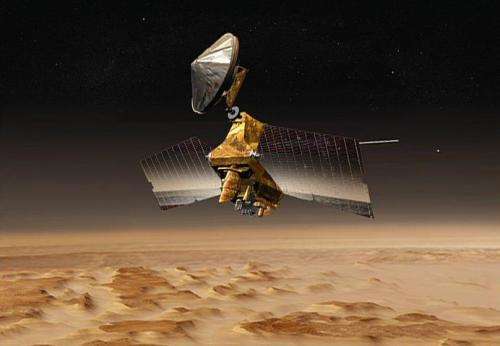NASA Mars orbiter safe after unplanned computer swap

(Phys.org) —NASA's long-lived Mars Reconnaissance Orbiter put itself into a precautionary safe standby mode March 9 after an unscheduled swap from one main computer to another. The mission's ground team has begun restoring the spacecraft to full operations.
"The spacecraft is healthy, in communication and fully powered," said Mars Reconnaissance Orbiter Project Manager Dan Johnston of NASA's Jet Propulsion Laboratory, Pasadena, Calif. "We have stepped up the communication data rate, and we plan to have the spacecraft back to full operations within a few days."
Mars Reconnaissance Orbiter's science observations and its relaying of communications from NASA's two active Mars rovers have been suspended. The rovers continue to use NASA's Mars Odyssey orbiter as a communications relay.
Entry into safe mode is the prescribed response by a spacecraft when it detects conditions outside the range of normal expectations. Mars Reconnaissance Orbiter has experienced unplanned computer swaps triggering safe-mode entry four times previously, most recently in November 2011. The root cause of the previous events has not been determined. The spacecraft has also experienced safe-mode entries that have not involved computer swaps.
Unlike any previous safe-mode entries experienced in this mission, the March 9 event included a swap to a redundant radio transponder on the orbiter. While the mission resumes operations with this transponder, engineers are investigating the status of the one that is now out of service.
NASA's Mars Reconnaissance Orbiter entered orbit around Mars eight years ago, on March 10, 2006. Since then, it has returned more data than all other past and current interplanetary missions combined. The mission met all its science goals in a two-year primary science phase. Three extensions, the latest beginning in 2012, have added to the science returns. The longevity of the mission has given researchers tools to study seasonal and longer-term changes on the Red Planet.
Provided by NASA





















